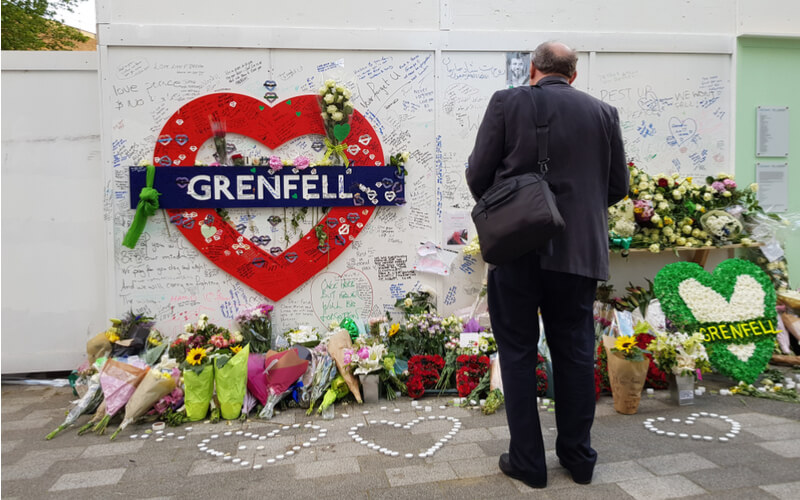Summerland to Grenfell - 44 years of un-learning
The death toll of the Grenfell Tower fire makes it one of the worst peacetime building fires of the last hundred years, not only in the United Kingdom but in the whole of Western Europe. Of these, it is the only one that was in a residential building.

In a letter to the Financial Times the day after the fire, I made a connection between the Grenfell fire and another tragic fire, that at the Summerland Leisure Centre in Douglas in the Isle of Man in August 1973. Few people know of it. 51 people lost their lives. This was the greatest loss of life in a building fire in the United Kingdom for nearly half a century. The building was a holiday leisure centre, very different in structure and in purpose from Grenfell Tower. But the two fires have striking similarities.
Summerland was remarkable for the speed with which the fire spread. The fire started in a hut placed against a wall with a combustible cladding. The cladding formed the outer leaf of a cavity wall, the inner leaf of which was made of combustible fibreboard. The cavity had no fire stopping.
The fire took hold on the inner face of the cladding, inside the cavity, and spread fast, both horizontally and vertically. Fire soon broke through the fibreboard into the interior of the building at several levels. Within a few minutes it took hold of the acrylic wall and roof panels. A large part of the building was on fire within 20 minutes.
We can recall what the RIBA said 43 years ago, “Read, learn, and do not forget ...” But we did forget.
At the time, the Summerland fire had an enormous effect in the building industry. The RIBA Journal published a special issue called Anatomy of a Disaster. The RIBA said in its plainest English that “It is the responsibility of every RIBA member…to ensure that disasters like Summerland cannot recur.” There was an editorial plea to the whole industry not to forget, “Read, learn, and do not forget: those Summerland victims need not have died.”
In the Grenfell Tower fire, just as at Summerland, we had rapid fire spread vertically on the exterior of the building, caused by ignition of combustible cladding, with propagation inside an unstopped cavity. This allowed the fire to enter the building at many levels, compromising the compartmentation of the structure.
In both Summerland and Grenfell, we had combustible materials in cavities, where plastics acted as fuels. The cavities acted as chimneys to draw in the air. In both cases, there were very large quantities of these plastics. The Grenfell Tower was more or less entirely covered with combustible cladding and insulation, a total area of 6700 square metres.
In the seventies, as plastics came to be used more and more in buildings, the problems arising from their fire properties were a matter of great concern. Expanded polystyrene ceiling tiles and plastic foam upholstery caused deaths in house fires. These hazards were quickly blocked by legislation. There were serious fires involving plastics. Above all there was the Summerland fire to show us the peril.
Materials specialists and fire safety experts knew where the risks lay. But the period of great innovation in plastics manufacture was over. No major new commodity plastics came to market after that. So, by the eighties, specialists knew most of what there was to know about the fire properties of these materials.
Here is the question:
Given that the fire properties of plastics were known in the seventies, and given that we had understood the causes of the disaster at Summerland, how then could the Grenfell Tower fire happen?
We can recall what the RIBA said 43 years ago, “Read, learn, and do not forget ...” But we did forget. How was it that we collectively forgot what we knew then? First: I said in my letter to the Financial Times that the Grenfell fire was a failure of government. I meant that government carries ultimate responsibility for public safety, or often says that it does. This seems particularly clear-cut in the case of the Grenfell Tower fire, where the residents had little or no control over where they lived. But of course, responsibility for safety is shared somehow between public and private entities, including individuals. So, I also said that the British construction industry must take full responsibility as well.
And second: the reason that it was unthinkable for Grenfell to have happened in London in 2017 is that the UK once led the world in fire safety engineering. This country created the first government building research facility in the world in 1921, and a government-funded Fire Research Station followed soon after. The idea of compartmentation in controlling the spread of fire in large buildings was developed in this country. The design principles were set in a National Building Study published in 1946 and many fire test methods used worldwide were invented here.
So, what happened?
Between 1973 and 2017, there were three major changes. First, over these years, the industry’s regulatory framework was repeatedly changed, and probably weakened, partly in pursuit of a policy goal of deregulation.
Second, the public-service research base on which this framework depends has been removed. “Governments have sometimes neglected and sometimes fostered, but…until now, have never attempted to destroy their national organisation for building research.” I quote George Atkinson writing in 1996. Soon after, the attempt was successful.
Third, the building control process has been radically changed. Dame Judith Hackitt’s Grenfell review found that the building regulations were not fit for purpose. In my view, any further changes in the regulatory framework should start with a long hard look at the history of these 44 years.
Those of us who work in science and engineering know that making things successfully depends not only on having the instructions, but also on having skill and experience and know-how and judgement.
A catastrophic major fire is low-probability, high-severity risk. It is a hazard outside the experience of almost all of us. The fire behaviour of different forms of construction, and the combustion properties of plastics are matters of first-hand experience for just a handful of specialists. Priceless knowledge. How do we capture and retain that sort of priceless knowledge for our collective benefit?

